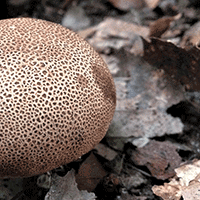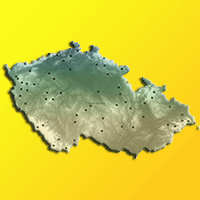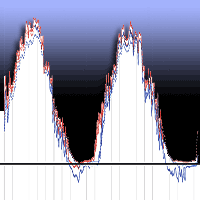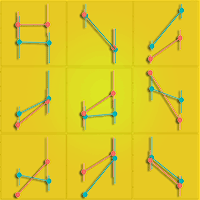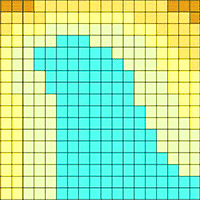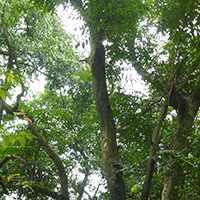Long-distance-exploration type (LDET) ectomycorrhizae have been reported to be best adapted to infertile soils, but variation within LDET ectomycorrhizae have not been thoroughly examined. Concentrations of nitrogen (N) and carbon (C) in LDET ectomycorrhizae were examined in Xerocomus-Pinus sylvestris and Scleroderma-Quercus petraea ectomycorrhizae. The study determined how concentrations of these elements vary in ectomycorrhizae in fertile (organic, uppermost mineral) and infertile (brunic) soil layers. The organic horizon in both Scots pine and sessile oak forest soils had the highest mineral status and exchange cations. In contrast, low mineral concentrations, high base saturation, and pH were characteristic of the brunic horizon in both forest stands. Xerocomus ectomycorrhizae had a higher concentration of N in the fertile (organic and uppermost mineral) soil horizons (3.4%) than in the infertile (brunic) soil horizon (2.2%). N concentration in Scleroderma ectomycorrhizae varied from 2.8%-3.0 % and did not differ between the studied soil horizons. The mean concentration of carbon in Xerocomus ectomycorrhizae varied from 29%-46% in Scots pine stands and from 41%-44% in Scleroderma ectomycorrhizae in sessile oak stands. The concentration of carbon in both Xerocomus and Scleroderma ectomycorrhizae was significantly higher in the fertile horizons (organic and uppermost mineral) compared to the brunic (infertile) horizon. In summary, the analysis conducted in the present study indicates that the LDET ectomycorrhizae, Xerocomus and Scleroderma, possess inherent variations in C and N content to manage soil resources.
Keywords
, , , , ,
Citation
Trocha LK, Bulaj B, Durska A, Frankowski M, Mucha J (2021). Not all long-distance-exploration types of ectomycorrhizae are the same: differential accumulation of nitrogen and carbon in Scleroderma and Xerocomus in response to variations in soil fertility. iForest 14: 48-52. - doi: 10.3832/ifor3594-013
Academic Editor
Daniela Baldantoni
Paper history
Received: Jul 21, 2020
Accepted: Nov 08, 2020
First online: Jan 18, 2021
Publication Date: Feb 28, 2021
Publication Time: 2.37 months
© SISEF - The Italian Society of Silviculture and Forest Ecology 2021
Open Access
This article is distributed under the terms of the Creative Commons Attribution-Non Commercial 4.0 International (https://creativecommons.org/licenses/by-nc/4.0/), which permits unrestricted use, distribution, and reproduction in any medium, provided you give appropriate credit to the original author(s) and the source, provide a link to the Creative Commons license, and indicate if changes were made.

Breakdown by View Type
(Waiting for server response...)
Article Usage
Total Article Views: 36138
(from publication date up to now)
Breakdown by View Type
HTML Page Views: 30504
Abstract Page Views: 2783
PDF Downloads: 2264
Citation/Reference Downloads: 4
XML Downloads: 583
Web Metrics
Days since publication: 1789
Overall contacts: 36138
Avg. contacts per week: 141.40
Article Citations
Article citations are based on data periodically collected from the Clarivate Web of Science web site
(last update: Mar 2025)
Total number of cites (since 2021): 3
Average cites per year: 0.60
Publication Metrics
by Dimensions ©
Articles citing this article
List of the papers citing this article based on CrossRef Cited-by.
(1)
Agerer R (2001)Exploration types of ectomycorrhizae. A proposal to classify ectomycorrhizal mycelia systems according to their patterns of differentiation and putative ecological importance. Mycorrhiza 11: 107-114.
CrossRef |
Gscholar
(2)
Agerer R (2006)Fungal relationships and structural identity of their ectomycorrhizae. Mycological Progress 5: 67-107.
CrossRef |
Gscholar
(3)
Baier R, Ingenhaag J, Blaschke H, Göttlein A, Agerer R (2006)Vertical distribution of an ectomycorrhizal community in upper soil horizons of a young Norway spruce (
Picea abies [L.] Karst.) stand of the Bavarian Limestone Alps. Mycorrhiza 16: 197-206.
CrossRef |
Gscholar
(4)
Bidartondo MI, Ek H, Wallander H, Söderström B (2001)Do nutrient additions alter carbon sink strength of ectomycorrhizal fungi? New Phytologist 151: 543-550.
CrossRef |
Gscholar
(5)
Bogar L, Peay K, Kornfeld A, Huggins J, Hortal S, Anderson I, Kennedy P (2019)Plant-mediated partner discrimination in ectomycorrhizal mutualisms. Mycorrhiza 29: 97-111.
CrossRef |
Gscholar
(6)
Chen W, Zeng H, Eissenstat DM, Dali Guo D (2013)Variation of first-order root traits across climatic gradients and evolutionary trends in geological time. Global Ecology and Biogeography 22: 846-856.
CrossRef |
Gscholar
(7)
Chen W, Koide RT, Adams TS, DeForest JL, Cheng L, Eissenstat DM (2016)Root morphology and mycorrhizal symbioses together shape nutrient foraging strategies of temperate trees. Proceedings of the National Academy of Sciences USA 113: 8741-8746.
CrossRef |
Gscholar
(8)
Chen W, Eissenstat DM, Koide RT (2018)Root diameter predicts the extramatrical hyphal exploration distance of the ectomycorrhizal fungal community. Ecosphere 9 (4): e02202.
CrossRef |
Gscholar
(9)
Courty P-E, Buée M, Diedhiou AG, Frey-Klett P, Le Tacon F, Rineau F, Turpault M-P, Uroz S, Garbaye J (2010)The role of ectomycorrhizal communities in forest ecosystem processes: New perspectives and emerging concepts. Soil Biology and Biochemistry 42: 679-698.
CrossRef |
Gscholar
(10)
Finlay RD, Frostegård A, Sonnerfeldt A-M (1992)Utilization of organic and inorganic nitrogen sources by ectomycorrhizal fungi in pure culture and in symbiosis with
Pinus contorta Dougl. ex Loud. New Phytologist 120: 105-115.
CrossRef |
Gscholar
(11)
Fober H (2006)Odzywianie mineralne. w: “Nasze drzewa lesne- Deby” [Mineral nutrition. In: “Tree species of Poland - Oaks”] (Boratynski A, Bugala W eds). Bogucki Wydawnictwo Naukowe, Kórnik, Poznan, Poland, pp. 232-264. [in Polish]
Gscholar
(12)
Gardes M, Bruns TD (1993)ITS primers with enhanced specificity for basidiomycetes - Application to the identification of mycorrhizae and rusts. Molecular Ecology 2: 113-118.
CrossRef |
Gscholar
(13)
Hobbie EA, Agerer R (2010)Nitrogen isotopes in ectomycorrhizal sporocarps correspond to belowground exploration types. Plant and Soil 327: 71-83.
CrossRef |
Gscholar
(14)
Hobbie EA, Colpaert JV (2003)Nitrogen availability and colonization by mycorrhizal fungi correlate with nitrogen isotope patterns in plants. New Phytologist 157: 115-126.
CrossRef |
Gscholar
(15)
Hobbie EA, Hofmockel KS, Van Diepen LTA, Lilleskov EA, Ouimette AP, Finzi AC (2014)Fungal carbon sources in a pine forest: evidence from a
13C-labeled global change experiment. Fungal Ecology 10: 91-100.
CrossRef |
Gscholar
(16)
Högberg MN, Myrold DD, Giesler R, Högberg P (2006)Contrasting patterns of soil N cycling in model ecosystems of Fennoscandian boreal forests. Oecologia 147: 96-107.
CrossRef |
Gscholar
(17)
Högberg P, Johannisson C, Yarwood S, Callesen I, Näsholm T, Myrold DD, Högberg MN (2011)Recovery of ectomycorrhiza after “nitrogen saturation” of a conifer forest. New Phytologist 189: 515-525.
CrossRef |
Gscholar
(18)
Kabala C, Switoniak M, Charzynski P (2016)Correlation between the Polish Soil Classification (2011) and international soil classification system World Reference Base for Soil Resources (2015). Soil Science Annual 67: 88-100.
CrossRef |
Gscholar
(19)
Kottke I, Qian XM, Pritsch K, Haug I, Oberwinkler F (1998)Xerocomus badius - Picea abies, an ectomycorrhiza of high activity and element storage capacity in acidic soil. Mycorrhiza 7: 267-275.
CrossRef |
Gscholar
(20)
Kuyper TW, Landeweert R (2002)Vertical niche differentiation by hyphae of ectomycorrhizal fungi in soil. New Phytologist 156: 323-325.
CrossRef |
Gscholar
(21)
Landeweert R, Hoffland E, Finlay RD, Kuyper TW, Van Breemen N (2001)Linking plants to rocks: ectomycorrhizal fungi mobilize nutrients from minerals. Trends in Ecology and Evolution 16: 248-254.
CrossRef |
Gscholar
(22)
Lilleskov EA, Hobbie EA, Fahey TJ (2002)Ectomycorrhizal fungal taxa differing in response to nitrogen deposition also differ in pure culture organic nitrogen use and natural abundance of nitrogen isotopes. New Phytologist 154: 219-231.
CrossRef |
Gscholar
(23)
Lilleskov EA, Hobbie EA, Horton TR (2011)Conservation of ectomycorrhizal fungi: exploring the linkages between functional and taxonomic responses to anthropogenic N deposition. Fungal Ecology 4: 174-183.
CrossRef |
Gscholar
(24)
Lindahl BD, Tunlid A (2015)Ectomycorrhizal fungi - potential organic matter decomposers, yet not saprotrophs. New Phytologist 205: 1443-1447.
CrossRef |
Gscholar
(25)
Lyr H, Hoffman G (1967)Growth rates and growth periodicity of tree roots. International Review of Forest Research 2: 181-236.
CrossRef |
Gscholar
(26)
Morrison EW, Frey SD, Sadowsky JJ, Van Diepen LTA, Thomas WK, Pringle A (2016)Chronic nitrogen additions fundamentally restructure the soil fungal community in a temperate forest. Fungal Ecology 23: 48-57.
CrossRef |
Gscholar
(27)
Nehls U, Göhringer F, Wittulsky S, Dietz S (2010)Fungal carbohydrate support in the ectomycorrhizal symbiosis: a review. Plant Biology 12: 292-301.
CrossRef |
Gscholar
(28)
Nygren CM, Edqvist J, Elfstrand M, Heller G, Taylor AFS (2007)Detection of extracellular protease activity in different species and genera of ectomycorrhizal fungi. Mycorrhiza 17: 241-248.
CrossRef |
Gscholar
(29)
Ostonen I, Helmisaari H-S, Borken W, Tedersoo L, Kukumagi M, Bahram M, Lindroos A-J, Nojd P, Uri V, Merila P, Asi E, Lohmus K (2011)Fine root foraging strategies in Norway spruce forests across a European climate gradient. Global Change Biology 17: 3620-3632.
CrossRef |
Gscholar
(30)
Pena R, Offermann C, Simon J, Naumann PS, Geßler A, Holst J, Dannenmann M, Mayer H, Kögel Knabner I, Rennenberg H, Polle A (2010)Girdling affects ectomycorrhizal fungal (EMF) diversity and reveals functional differences in EMF community composition in a beech forest. Applied and Environmental Microbiology 76: 1831-1841.
CrossRef |
Gscholar
(31)
Pena R, Lang C, Lohaus G, Boch S, Schall P, Schöning I, Ammer C, Fischer M, Polle A (2017)Phylogenetic and functional traits of ectomycorrhizal assemblages in top soil from different biogeographic regions and forest types. Mycorrhiza 27: 233-245.
CrossRef |
Gscholar
(32)
Przybylski T (1993)Biologia sosny zwyczajnej [Biology of
Pinus sylvestris] (Bialobok S, Boratynski A, Bugala W eds). Instytut Dendrologii Polskiej Akademii Nauk, Sorus, Poznan-Kórnik, Poland, pp. 264-265. [in Polish]
Gscholar
(33)
Read DJ, Perez-Moreno J (2003)Mycorrhizas and nutrient cycling in ecosystems - a journey towards relevance? New Phytologist 157: 475-492.
CrossRef |
Gscholar
(34)
Roberts J (1976)A study of root distribution and growth in a
Pinus sylvestris L. (Scots pine) plantation in east Anglia. Plant and Soil 44: 607-621.
CrossRef |
Gscholar
(35)
Saravesi K, Markkola A, Rautio P, Roitto M, Juha Tuomi J (2008)Defoliation causes parallel temporal responses in a host tree and its fungal symbionts. Oecologia 156: 117-123.
CrossRef |
Gscholar
(36)
Talbot JM, Bruns TD, Smith DP, Branco S, Glassman SI, Erlandson S, Vilgalys R, Peay KG (2013)Independent roles of ectomycorrhizal and saprotrophic communities in soil organic matter decomposition. Soil Biology and Biochemistry 57: 282-291.
CrossRef |
Gscholar
(37)
Taylor AFS, Fransson PM, Högberg P, Högberg MN, Plamboeck AH (2003)Species level patterns in
13C and
15N abundance of ectomycorrhizal and saprotrophic fungal sporocarps. New Phytologist 159: 757-774.
CrossRef |
Gscholar
(38)
Tedersoo L, Naadel T, Bahram M, Pritsch K, Buegger F, Leal M, Kõljalg U, Põldmaa K (2012)Enzymatic activities and stable isotope patterns of ectomycorrhizal fungi in relation to phylogeny and exploration types in an afrotropical rain forest. New Phytologist 195: 832-843.
CrossRef |
Gscholar
(39)
Teramoto M, Wu B, Hogetsu T (2016)Pathway and sink activity for photosynthate translocation in
Pisolithus extraradical mycelium of ectomycorrhizal
Pinus thunbergii seedlings. Mycorrhiza 26: 453-464.
CrossRef |
Gscholar
(40)
Trocha LK, Mucha J, Eissenstat DM, Reich PB, Oleksyn J (2010)Ectomycorrhizal identity determines respiration and concentrations of nitrogen and nonstructural carbohydrates in root tips: a test using
Pinus sylvestris and
Quercus robur saplings. Tree Physiology 30: 648-654.
CrossRef |
Gscholar
(41)
Trocha LK, Weiser E, Robakowski P (2016)Interactive effects of juvenile defoliation, light conditions, and interspecific competition on growth and ectomycorrhizal colonization of
Fagus sylvatica and
Pinus sylvestris seedlings. Mycorrhiza 26: 47-56.
CrossRef |
Gscholar
(42)
Trocha LK, Bulaj B, Kutczynska P, Mucha J, Rutkowski P, Zadworny M (2017)The interactive impact of root branch order and soil genetic horizon on root respiration and nitrogen concentration. Tree Physiology 37: 1055-1068.
CrossRef |
Gscholar
(43)
Van Der Heijden EW, Kuyper TW (2003)Ecological strategies of ectomycorrhizal fungi of
Salix repens: root manipulation
versus root replacement. Oikos 103: 668-680.
CrossRef |
Gscholar
(44)
White TJ, Bruns T, Lee S, Taylor J (1990)Amplification and direct sequencing of fungal ribosomal RNA genes for phylogenetics. In: “PCR Protocols: A Guide to Methods and Applications” (Innis DHGMA, Sninsky JJ, White TJ eds). Academic Press, New York, USA, pp. 315-322.
CrossRef |
Gscholar
